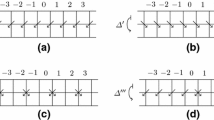Abstract
For a finite group G and a finite set A, we study various algebraic aspects of cellular automata over the configuration space \(A^G\). In this situation, the set \(\mathrm {CA}(G;A)\) of all cellular automata over \(A^G\) is a finite monoid whose basic algebraic properties had remained unknown. First, we investigate the structure of the group of units \(\mathrm {ICA}(G;A)\) of \(\mathrm {CA}(G;A)\). We obtain a decomposition of \(\mathrm {ICA}(G;A)\) into a direct product of wreath products of groups that depends on the numbers \(\alpha _{[H]}\) of periodic configurations for conjugacy classes [H] of subgroups of G. We show how the numbers \(\alpha _{[H]}\) may be computed using the Möbius function of the subgroup lattice of G, and we use this to improve the lower bound recently found by Gao, Jackson and Seward on the number of aperiodic configurations of \(A^G\). Furthermore, we study generating sets of \(\mathrm {CA}(G;A)\); in particular, we prove that \(\mathrm {CA}(G;A)\) cannot be generated by cellular automata with small memory set, and, when all subgroups of G are normal, we determine the relative rank of \(\mathrm {ICA}(G;A)\) on \(\mathrm {CA}(G;A)\), i.e. the minimal size of a set \(V \subseteq \mathrm {CA}(G;A)\) such that \(\mathrm {CA}(G;A) = \langle \mathrm {ICA}(G;A) \cup V \rangle\).

Similar content being viewed by others
References
Araújo J, Bentz W, Mitchell JD, Schneider C (2015) The rank of the semigroup of transformations stabilising a partition of a finite set. Math Proc Camb Philos Soc 159:339–353
Araújo J, Schneider C (2009) The rank of the endomorphism monoid of a uniform partition. Semigroup Forum 78:498–510
Cameron PJ (1994) Combinatorics: topics, techniques, algorithms. Cambridge University Press, Cambridge
Castillo-Ramirez A, Gadouleau M (2016) Ranks of finite semigroups of one-dimensional cellular automata. Semigroup Forum 93(2):347–362
Castillo-Ramirez A, Gadouleau M (2016) On finite monoids of cellular automata. In: Cook M, Neary T (eds.) Cellular automata and discrete complex systems. LNCS 9664, Springer International Publishing, Berlin, 90–104.
Ceccherini-Silberstein T, Coornaert M (2010) Cellular automata and groups. Springer monographs in mathematics. Springer, Berlin Heidelberg
Cyr V, Bryna K (2015) The automorphism group of a shift of linear growth: beyond transitivity. Forum Math Sigma 3(e5):1–27
Dedekind R (1897) Ueber gruppen, deren sämmtliche theiler normaltheiler sind (German). Math Ann 48(4):548–561
Dixon JD, Mortimer B (1996) Permutation groups. Graduate texts in mathematics 163. Springer, New York
Ganyushkin O, Mazorchuk V (2009) Classical finite transformation semigroups: an introduction. Algebra and applications 9. Springer, London
Gao S, Jackson S, Seward B (2016) Group colorings and bernoulli subflows. Mem Am Math Soc 241(1141):1–239
Gomes GMS, Howie JM (1987) On the ranks of certain finite semigroups of transformations. Math Proc Camb Philos Soc 101:395–403
Gray RD (2014) The minimal number of generators of a finite semigroup. Semigroup Forum 89:135–154
Hartman Y (2012) Large semigroups of cellular automata. Ergod Theory Dyn Syst 32:1991–2010
Hawkes T, Isaacs IM, Özaydin M (1989) On the möbius function of a finite group. Rocky Mt J Math 19(4):1003–1034
Howie JM, McFadden RB (1990) Idempotent rank in finite full transformation semigroups. Proc Royal Soc Edinb 114A:161–167
Kari J (2005) Theory of cellular automata: a survey. Theor Comput Sci 334:3–33
Kerber A (1999) Applied finite group actions, 2nd ed. Algorithms and combinatorics 19, Springer, Berlin
Salo V (2015) Groups and monoids of cellular automata. In: Kari J (ed.) Cellular automata and discrete complex systems. LNCS 9099, 17–45, Springer Berlin Heidelberg
Acknowledgements
This work was supported by the EPSRC grant EP/K033956/1. We kindly thank Turlough Neary and Matthew Cook for their invitation to submit this paper and for the organisation of the conference AUTOMATA 2016. We also thank the referees of this paper for their insightful suggestions.
Author information
Authors and Affiliations
Corresponding author
Rights and permissions
About this article
Cite this article
Castillo-Ramirez, A., Gadouleau, M. Cellular automata and finite groups. Nat Comput 18, 445–458 (2019). https://doi.org/10.1007/s11047-017-9640-3
Published:
Issue Date:
DOI: https://doi.org/10.1007/s11047-017-9640-3




